It is never easy to find the right words while writing a condolence letter to express your sympathy and grief.
Since the expression of sympathy is a delicate matter, we have a few examples and tips to ease the writing process.
Download Editable Condolence & Sympathy Letters
No matter how close or distant you are with the bereaved, expressing your condolences is good for both them and you. If you had a relationship with the person who passed away, you must write a few words for their loved ones.
While buying a sympathy card may seem like the easy way out, nothing eases pain like a heartfelt handwritten message to ride out a difficult time.
We will discuss some guidelines and tips for writing such letters in different situations. In the end, each letter should be unique, with your personal touch.
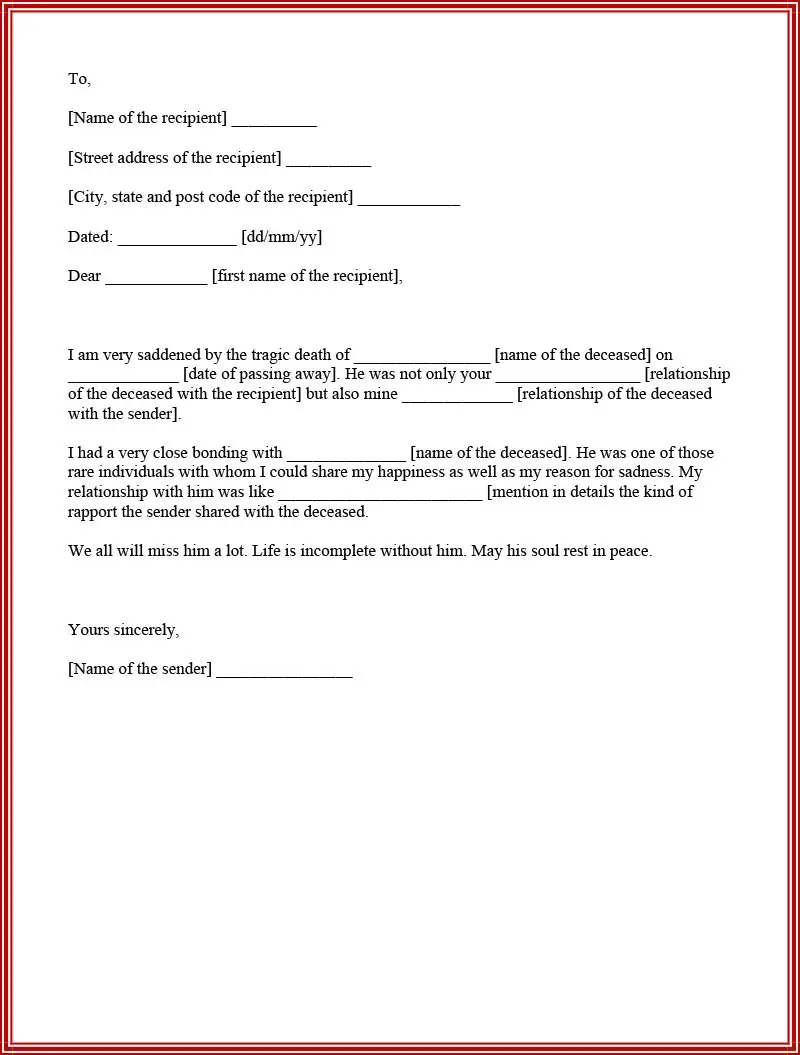
For Loss of a Loved One
Losing a loved one is extremely painful for anyone.
Begin your letter with an appropriate greeting. Write the message from your heart and frame it in a way that sounds like something you would have said in person.
Mention a few words about special memories you have with the deceased. Memories are usually comforting and may bring a smile to the grieving person.
You should also offer help to a grieving family member, in any capacity you can. Make a sincere offer instead of just mentioning it for the sake of sounding nice.
Close the letter appropriately. It should covey your condolences and sympathy.
Moreover, the letter should also reflect on your relationship with the people mourning.
Use below given condolence letter:
- on death of father
- for loss of mother
- to a friend who lost her husband
- to a grieving husband
- to a loved one
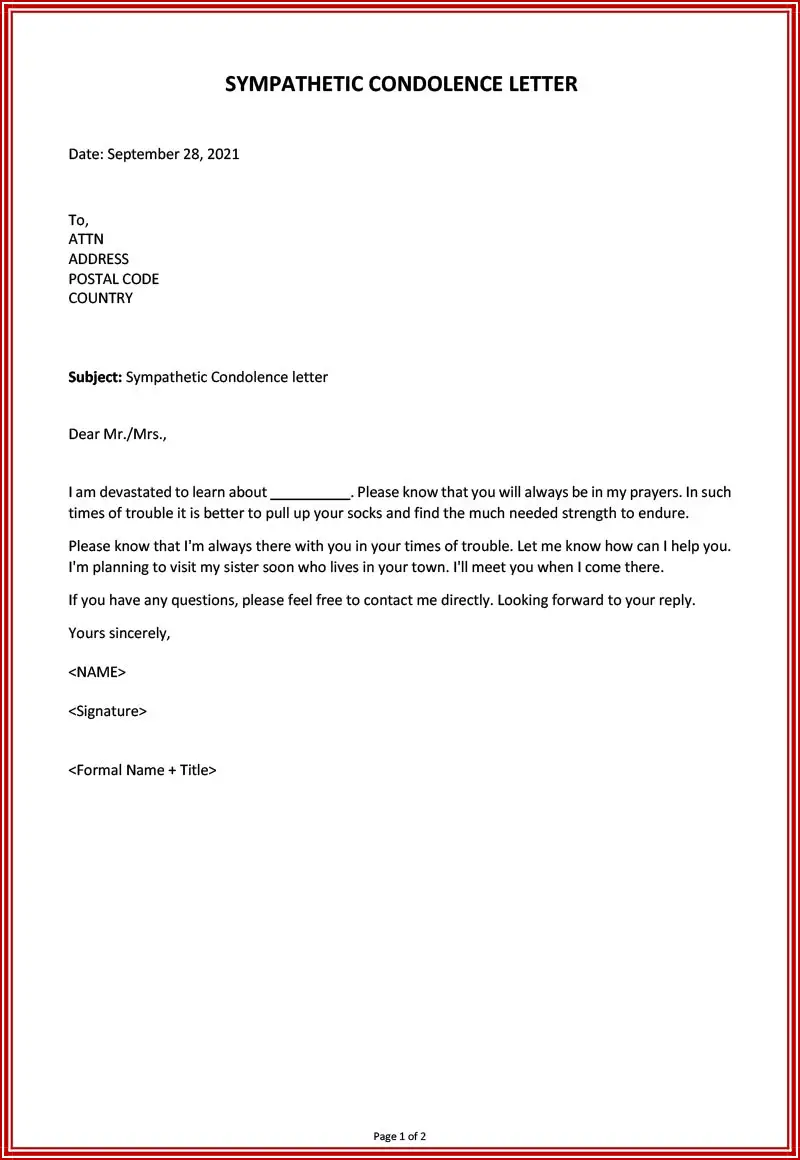
Official Letter
Offering condolences as an organization is a little different from sending such letters on a personal note.
They are important since they provide sympathy and strength to the ones grieving to face the situation. The letter does not need to be handwritten.
Follow these guidelines to write an effective letter.
- Use the organization’s official letterhead for the communication.
- Please don’t get too personal; the tone of your letter should be formal since you are writing it on behalf of the organization.
- Acknowledge the loss of your member.
- Mention how important the deceased was to the establishment and that their absence will be felt.
- Mention whatever the deceased achieved in your organization. The recipients may be happy to see good things being talked about them.
- Pay your respects to the deceased.
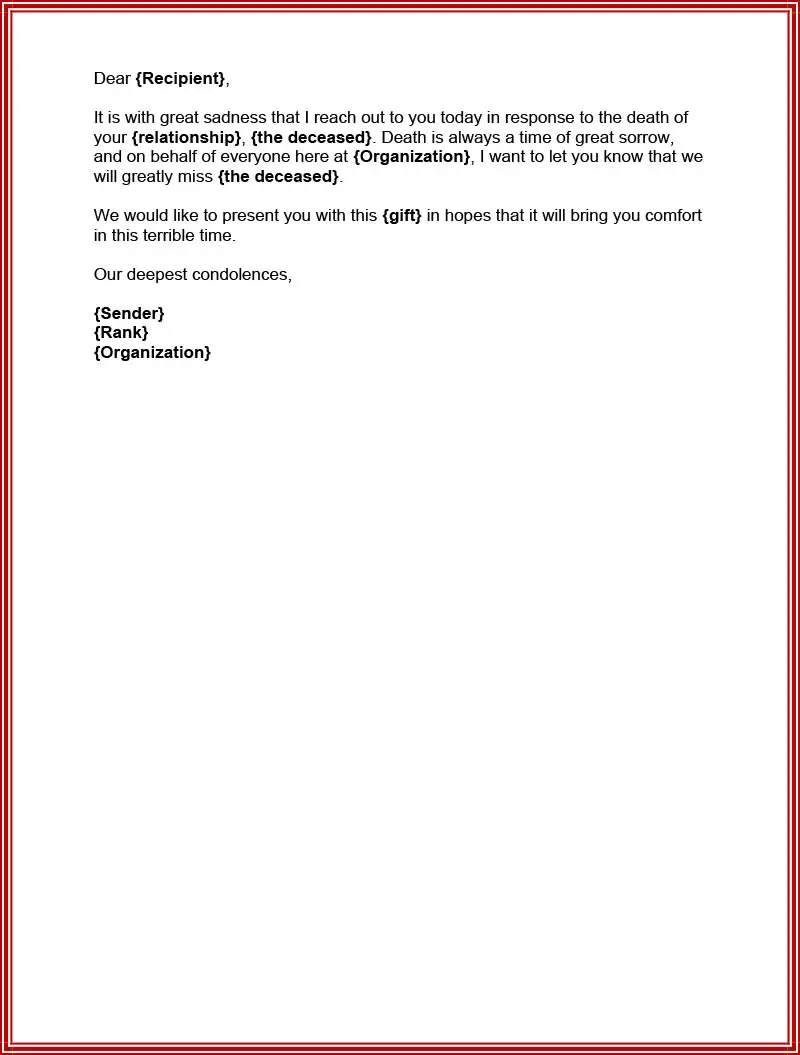
From School
When a member of a school system dies, the school sends a letter of sympathy to the family of the deceased.
While students make up the major population of a school, staff members also need to be remembered. Let us look at a few tips to keep in mind while reaching out to a family dealing with death.
- Acknowledge their loss and tell them how sorry you are.
- Mention special qualities of the deceased.
- Recall memories of the deceased.
- Mention how their presence was important to your establishment.
- Remind the mourning family of their own strengths.
- Offer your help, but be specific.
- End with a sentimental statement.

From Organization
As a business, it is important for you to show that you care about all your assets.
Here are a few things you should remember while writing a letter of sympathy on behalf of an organization.
- Express your gratitude for the person that died.
- Be empathetic.
- Keep the message brief yet meaningful.
- Proofread for any grammatical errors.
- Be comforting while using a professional tone.
- Don’t add feelings unless required.
- Offer assistance, but don’t impose yourself on the recipient.
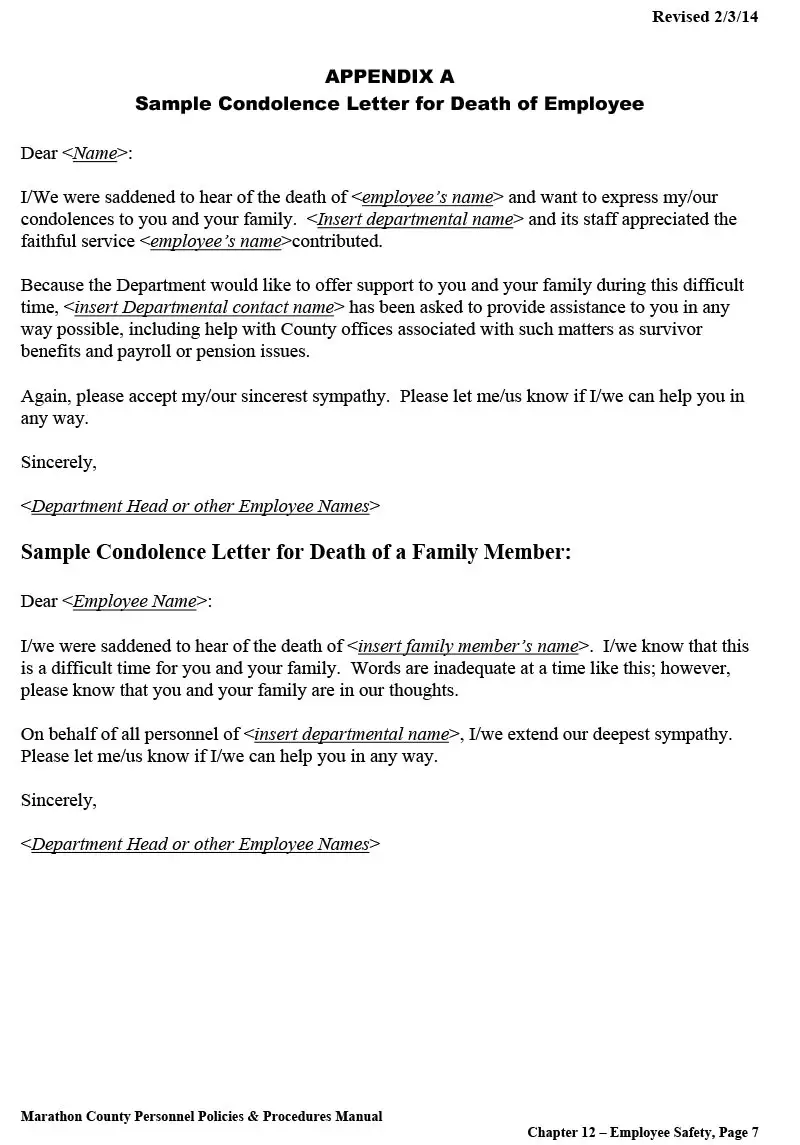
From Doctor to a Family
Since the doctor usually has a direct relationship with the patient who passed away and knew them well, the letter of condolence is quite crucial.
Often, doctors get devastated when they get to know that their patient is no more. They take it as a personal failure and get pretty sad.
However, their letter should show the family that they are equally aggrieved by the news of the loss. Let’s look at a few tips that you can use if you’re a doctor or are writing a letter on behalf of one.
- Fit everything in a single page.
- Prepare a handwritten letter instead of printing one.
- Acknowledge the loss.
- Mention good qualities of the patient.
- Say why you will miss the patient.
- Show your grief to the recipients.
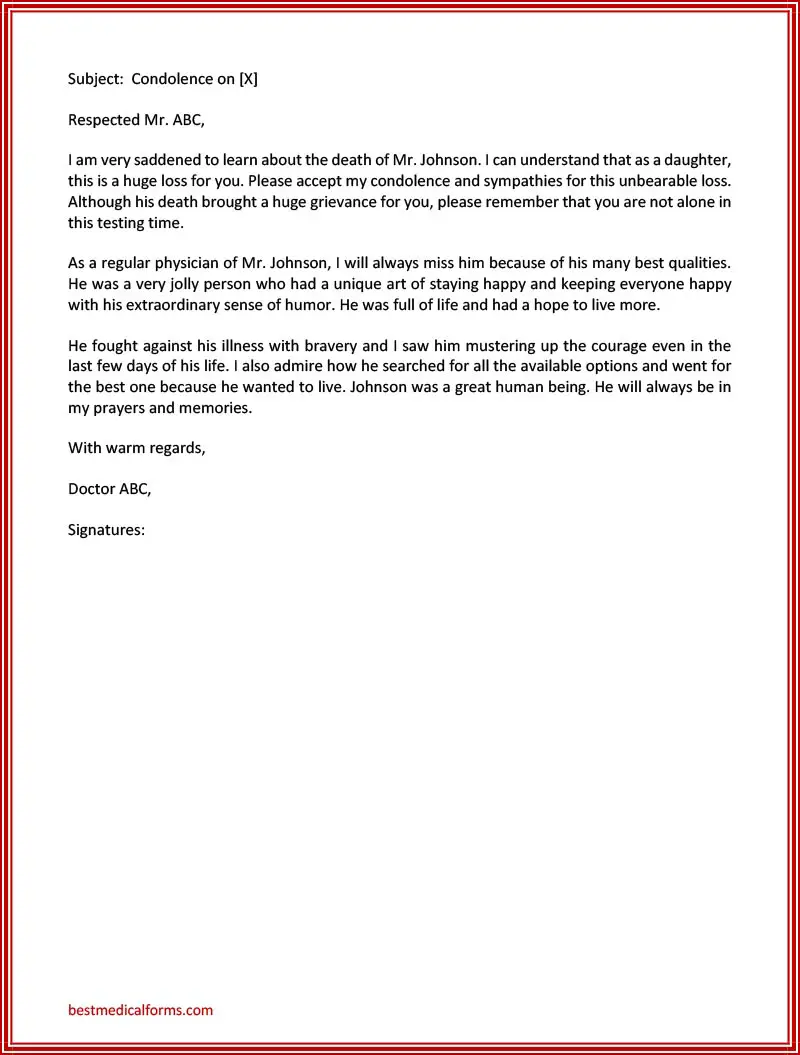
How to Write a Condolence Letter?
Here’s a breakdown of the step-by-step process to write an effective condolence letter.
Go for Handwritten Communication
Letters written by hand seem much more meaningful than an email or a printed sympathy card. Remember, people need warmth and comfort in such times, not something cold and impersonal.
All you need to do is find some stationery and pen down a thoughtful message.
Be Prompt & Brief
Sending a sympathy letter is a great gesture towards people in mourning. However, they may not have the emotional energy to read endless pages of condolences.
While writing such a letter, try limiting yourself to a couple of paragraphs. You can, of course, send a follow-up in the next few months.
The important thing is to send your condolences within three days of the unfortunate event, even if it is difficult for you to do so. Putting it off for later makes it look like it you don’t care enough.
Refer to the Deceased by Name
Once a person has passed away, people often feel like they shouldn’t mention the deceased’s name as it could hurt their friends or family.
In reality, that is not usually the case. People like to talk about their loved ones, even if it may bring them pain. So, refer to the deceased by name in your condolence letters.
Talk About the Good Memories & Qualities of the Deceased
Although it is important to be brief, you also want to be thoughtful in your sympathy letter.
People usually like to be reminded of the good memories and attributes of the deceased, so feel free to be specific.
You could mention the following things about the deceased in your sympathy letter to ease the grieving person:
- Mention their good qualities.
- Talk about their talents.
- Recount your personal favorite memory.
- Mention the good things you heard about them.
Do Not Overshadow the Family of the Deceased
When you write a condolence letter, you want to express your sympathy without undermining the feelings of the people in mourning.
Instead of using heavy terms like “devastated” or “heartbroken,” try to be sincere and say things like “sorry to hear” or “saddened to hear.” You do not want to be overdramatic and overshadow the feelings of a grieving family member or a friend.
Offer Specific Help
People often offer help in their letters but remain vague about how they can actually lend a hand. It ends up putting the bereaved in an uncomfortable position.
Try to be specific in how you can help by offering to do things you are comfortable with. Tangible offers are far more thoughtful than standard sympathy letters.
Writing something personal, like “please know that I will be happy to pick your kids up from school next week,” shows that you genuinely want to support the recipient while they deal with the death of their dear relative.
FAQs
Question: What is the best condolence message?
There is no formula for the best condolence message. Use a personal tone, as death is a delicate matter and should not be complicated.
Simple terms and phrases can make a huge impact. For example, “sorry to hear” or “saddened by the news” show support to the deceased’s dear ones in their difficult time.
Question: How do you express condolences?
Try to frame your message in your own words when you write a sympathy note instead of using a store-bought sympathy note.
Do not try to be too fancy or use complicated language to show you are sad that someone died. Instead, write as if you’re having a conversation with the recipient. Use simple phrases like “please accept my condolences” and “sorry for your loss.” You want to support the person through their grief.
Moreover, when a person goes through a difficult time, giving them a call can be comforting.
Question: What do you write when someone dies?
Here are a few things to include in your letter:
- Praise the deceased.
- Offer your condolences to the bereaved.
- Express sympathy for the loved one.
- Mention the deceased’s most cherished memory in your life.
- Offer help on a personal level.
- Talk about how dear the person was to you.
- Wish them well.
- Sign with your full name.
Question: How do you write simple condolence?
Being yourself is the key to write a simple condolence note. Don’t lace your sympathy note with flowery words like in an obituary. Instead, be there as a friend.
Here are a few things you should avoid while writing a sympathy letter.
- Don’t compare your feelings with the bereaved.
- Don’t try to be upbeat.
- Don’t say things like “they are in a better place now.”
- Don’t spin at a positive angle.
- Don’t comment on how the person died.
- Don’t talk about an afterlife.
- Don’t mention if the deceased owed you anything.
- Don’t ask the bereaved person to move on.
- Don’t impose religious activities such as prayers.
- Don’t comment on the funeral program.
- Don’t bring up an example of a similar death.
Conclusion
Picking the appropriate words to show your sympathy and offer condolences to people in mourning is a real challenge.
If you encounter a situation where you need to write such notes or letters, our templates will be of immense help. There are multiple examples for different situations to get your point across effectively.
Do share this article with your dear ones so that they know what to say in tough times like these.






